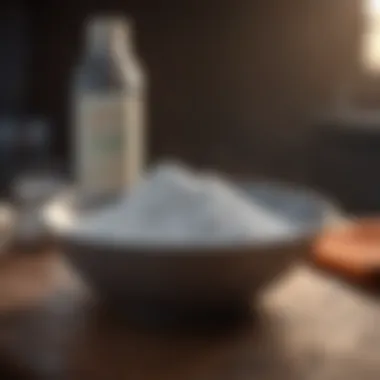Cleaning Stainless Steel with Baking Soda: Tips & Techniques


Intro
Stainless steel has become a staple in both modern kitchens and sleek bathrooms, admired for its durability and contemporary appeal. However, keeping these surfaces shining like new can sometimes feel like a Herculean task. This is where baking soda steps into the limelight. Not only is it a common household item, but it also possesses remarkable cleaning properties that many people overlook.
As simple as it may seem, this versatile powder packs a punch against grime and stains found on stainless steel. In this guide, we will delve into the effectiveness of baking soda as a cleaning agent for stainless steel, examine its chemical properties, and discuss various methods of application, all while addressing any potential concerns you might have. By the end, you will be well-equipped with the knowledge to make informed choices on cleaning your stainless steel appliances and fixtures.
Home Features
When it comes to integrating stainless steel surfaces into your home, it’s not just about aesthetics; it’s about creating an environment that balances functionality with style. For many homeowners, stainless steel appliances symbolize culinary expertise and modern luxury. Moreover, these surfaces often feature prominently in architectural designs, showcasing a seamless blend of innovation and tradition.
Architectural Marvels
Stainless steel is more than just a practical choice; it's part of architectural marvels that span from industrial lofts to suburban homes. With its reflective qualities, stainless steel can dramatically enhance natural light, making spaces feel more open and inviting. For example, in a minimalist kitchen, large stainless steel islands can serve as both functional workspaces and conversation starters.
Unique Design Elements
Think of backsplashes or extractor hoods made of stainless steel. These elements elevate the overall look of a room, providing a clean, polished finish that complements a variety of interior styles. Yet, maintaining these surfaces requires attention to detail, and that’s where baking soda comes into play. Imagine removing stubborn fingerprints or smudges with a simple paste made of baking soda and water — it’s efficient and friendly to both your wallet and the environment.
Effective Cleaning Methods
Using baking soda to clean stainless steel isn’t rocket science, but there are steps to ensure that you achieve optimal results. Here’s how to make it work for you:
- Create a Paste
Mix baking soda with water. Aim for a thick paste that can cling to surfaces — not too runny, but also not dry as a desert. - Apply to Surface
Gently rub the paste onto the stainless steel surface with a soft cloth. For tougher spots, consider using a non-abrasive sponge to scour away the grime without scratching the steel. - Rinse and Dry
After you’re done scrubbing, rinse the area with clean water to remove any residual baking soda. Then, dry it thoroughly with a soft cloth to prevent water spots and streaks.
"A clean kitchen is a sign of a wasted life. But a polished stainless steel surface? That’s a sign of dedication."
This adage might sound tongue-in-cheek, but it reflects the pride that comes with maintaining a clean home. The beauty of using baking soda is that it cleverly avoids the harsh chemicals found in many commercial cleaners, making it a safer choice for homes with kids and pets.
Culmination
Embracing baking soda as a cleaning agent for stainless steel is not just about achieving a sparkle; it’s also an eco-friendly approach to homekeeping. As we've seen, its versatility is matched only by its effectiveness, allowing homeowners to protect their investments while keeping their living spaces looking their best. Dive deeper into this cleaning method, and you may discover just how easy it can be to keep that stainless steel gleaming.
Intro to Stainless Steel Cleaning
Cleaning stainless steel can be a bit of a tricky endeavor for many, especially those who take pride in maintaining their appliances and surfaces in tiptop shape. A clean, shiny stainless steel can serve not only an aesthetic purpose but also play a role in hygiene, especially in kitchens where food is prepared.
One of the key elements to grasp here is that stainless steel is not just a single entity; it's an alloy that boasts properties making it resistant to corrosion and stains. This resistance, however, doesn’t mean it's completely invincible. Regular cleaning is necessary to maintain its alluring luster and prevent the accumulation of grime.
Characteristics of Stainless Steel
Stainless steel's charm lies in its unique composition. Made primarily of iron, chromium, and nickel, this material is known for its durability and resilience. What makes it particularly remarkable is its ability to resist tarnishing and rusting. When exposed to oxygen, the chromium reacts to form a thin, protective layer of chromium oxide, guarding the underlying metal. This layer can get compromised over time if not properly cared for, leading to dullness or even corrosion in some cases.
It’s worth noting that stainless steel comes in different grades and finishes, each varying in texture and resistance levels. Some surfaces feature a shiny, mirror-like finish, while others are more matte, creating a different aesthetic altogether. These finishes may react differently to various cleaning methods, so being aware of what type of stainless steel you're dealing with is a step in the right direction.
Importance of Correct Cleaning Methods
Not all cleaning products are created equal. Missteps in cleaning stainless steel can lead to scratches, dullness, and even damage that can be costly to rectify. Using abrasive cleaners might offer a quick fix for tough stains, but they can wreak havoc on those delicate finishes.
Adopting the correct cleaning methods ensures the longevity of your stainless steel surfaces. This ensures that not only do they look appealing but that they serve their functional purpose for years. Proper cleaning methods embodied with a gentle touch go a long way in preserving that glossy finish while ensuring the material stays free from harmful bacteria and stains.
In summary, understanding the characteristics of stainless steel and the importance of using appropriate cleaning methods sets the groundwork for ensuring these surfaces remain pristine. Choosing sustainable options like baking soda not only keeps them clean but aligns with a broader commitment to environmental responsibility.
Properties of Baking Soda


When it comes to using baking soda for cleaning, knowing its properties is crucial. Baking soda, or sodium bicarbonate, is a compound that has diverse applications, especially in home cleaning routines. This section dives into its chemical composition and functions as well as its versatility as a cleaner, laying the groundwork for understanding how it can effectively tackle the challenges associated with cleaning stainless steel.
Chemical Composition and Function
Baking soda is a simple compound comprised of sodium, hydrogen, carbon, and oxygen. When it comes into contact with acids or bases, it can react and produce carbon dioxide gas. This effervescence is not merely for show; it contributes to its cleaning capabilities. This reaction helps to loosen grime, grease, and stubborn stains without causing the damage that harsher chemicals might inflict.
For instance, the mild alkalinity of baking soda allows it to dissolve dirt and grease from surfaces. When working on stainless steel, its non-corrosive nature means that you can scrub away impurities while keeping the surface intact. It’s almost like having a gentle giant doing the heavy lifting—powerful enough for cleaning yet kind enough not to scratch delicate finishes.
"Baking soda combines functionality with safety, making it an ideal choice for cleaning delicate items like stainless steel."
This makes it an indispensable tool in a homeowner's cleaning arsenal. Beyond cleaning, it can also neutralize odors, which is a key consideration when cleaning surfaces that can harbor unwanted smells, such as sinks or appliances.
Natural Versatile Cleaner
One of the defining characteristics of baking soda is its versatility. It doesn’t just stop at cleaning stainless steel; it's like the Swiss Army knife of household cleaners. You can use it on a plethora of surfaces—kitchens, bathrooms, and even for laundry purposes. For folks who appreciate simplicity and efficiency, it's a welcome addition to any cleaning routine.
When tackling stainless steel, this type of cleaner showcases its natural powers. It can be used to deal with tarnish, fingerprints, and streaks, which are common eye sores. Also, unlike some commercial cleaners that can contain harmful chemicals, baking soda is typically safe to use around pets and children, adding another feather in its cap.
To make the most of its properties, many people combine it with vinegar—a classic duo. While the two react to create a bubbly fizz, their combined forces often lead to an enhanced cleaning experience. However, knowing when and how to mix them is important. Too much fizz can lead to a mess, which is the last thing you want when trying to keep your space tidy.
In summary, understanding the properties of baking soda not only reveals its unique benefits but also empowers you to utilize this versatile ingredient effectively. Its role as a natural, non-toxic cleaner is invaluable and positions it as a go-to option for maintaining cleanliness—even for those hard-to-clean stainless steel surfaces.
Benefits of Using Baking Soda on Stainless Steel
When it comes to keeping stainless steel surfaces pristine, the choice of cleaning agents can make a world of difference. Baking soda stands out as a particularly wise option, providing several significant advantages over conventional chemicals. This section delves into the primary benefits of using baking soda for cleaning stainless steel, illustrating its appeal for homeowners, professionals, and enthusiasts alike.
Non-Toxic Cleaning Alternative
In an age where environmental concerns take center stage, opting for non-toxic cleaning solutions has never been more important. Baking soda, or sodium bicarbonate as it’s scientifically known, is a natural substance that's not only effective but also safe for both people and pets. Unlike many commercial cleaners packed with harsh chemicals, baking soda can tackle grime without releasing harmful fumes into your home.
Using this gentle abrasive allows for a thorough cleaning process while remaining mindful of your health and the planet’s well-being. This approach ensures that surfaces remain not only clean but also free from residues that may pose risks with repeated exposure. It's particularly valuable in households with children or those hypersensitive to chemical agents.
Cost-Effectiveness
When financial considerations come into play, baking soda proves to be a budget-friendly ally. Affordably priced, it provides a cost-effective solution for the ongoing maintenance of stainless steel surfaces. A little goes a long way, making this cleaning powerhouse suitable for most budgets. For instance, a single box of baking soda can be used for multiple cleaning sessions, thus reducing the need for frequent purchases of specialized and often pricey cleaners.
Moreover, many people may already have baking soda in their pantry, negating the need for additional trips to the store. This frugality does not mean skimping on quality; rather, baking soda matches or even surpasses some conventional cleaners in its ability to remove stains and restore shine.
Environmentally Friendly Option
Choosing cleaning products with the environment in mind is paramount nowadays. Baking soda stands tall in this regard, as it’s fully biodegradable and poses minimal risk to aquatic life when washed down the drain. In contrast to some traditional cleaners, which can contain phosphates and other pollutants, baking soda cleans effectively without contributing to waterway contamination.
Furthermore, using baking soda as a cleaning agent plays into the larger picture of sustainable living. By opting for a product that is both effective and earth-conscious, consumers can take small yet meaningful steps towards reducing their ecological footprint. This choice resonates particularly well with interior design aficionados and environmental advocates, who not only seek beauty in their spaces but also value sustainability in their lifestyles.
"Baking soda is more than just a kitchen staple; it embodies responsible cleaning and a commitment to the planet."
In summary, the advantages of using baking soda for cleaning stainless steel surfaces extend beyond mere sparkle. With its non-toxic nature, cost-effectiveness, and environmental benefits, baking soda is an invaluable ally for anyone looking to maintain a clean and healthy home. As we unravel more methods of application in the subsequent sections, the profound impacts of this humble compound will become even more apparent.
How to Use Baking Soda for Cleaning
Understanding how to effectively harness the power of baking soda for cleaning stainless steel is essential for keeping surfaces sparkling and free of tarnish. Not only is baking soda versatile in its application, but using it also carries benefits for both your appliances and the environment. Here, we delve into specific methods that can help you achieve the best results.


Basic Cleaning Method
Using baking soda for basic cleaning is straightforward, yet the effects can be impressive. Start by creating a paste using three parts baking soda to one part water. This simple mixture creates a gentle abrasive that can break down grime without scratching the stainless steel's surface.
- Apply the Paste: Use a soft cloth or sponge to apply the paste directly onto the stained area of the stainless steel. Make sure to cover all spots you wish to clean.
- Gently Scrub: With a light hand, scrub in the direction of the grain of the metal. This step is crucial, as scrubbing against the grain can create micro-scratches, making the surface appear duller over time.
- Rinse and Dry: After scrubbing, rinse the area thoroughly with warm water. Finally, dry with a clean, soft towel to avoid water spots.
This fundamental method is not only effective but creates a non-toxic way to keep your surfaces looking their best.
Combining with Other Ingredients
While baking soda is a star player on its own, combining it with other natural ingredients can create a potent cleaning solution. You might consider using a splash of vinegar or lemon juice in conjunction with baking soda for deeper cleaning potency.
- Vinegar: When mixed with baking soda, vinegar activates release carbon dioxide, which can help lift stubborn stains. Just sprinkle baking soda on the surface, then spray vinegar over it. The fizzing action can lift grime.
- Lemon Juice: This offers not only a pleasant scent but its acidity can help to break down stains while leaving surfaces fresh.
Tip: Always do a small patch test in an inconspicuous area to ensure compatibility before applying widely across your stainless steel surfaces.
Timing and Application Techniques
Timing is everything when using baking soda as a cleaning agent. When you apply the paste or combine it with other ingredients, give it some time to work its magic.
- Let It Sit: After applying the paste or mixture, allow it to rest on the surface for about 10-15 minutes. This gives the ingredients time to react and penetrate the stains, making them easier to remove.
- Regular Maintenance: For maintained shine, consider incorporating baking soda cleaning into your regular cleaning routine. Doing so can prevent build-up and extend the life of your stainless steel appliances.
In summary, utilizing baking soda effectively requires understanding the methods of application and timing. Each process enhances the cleaning experience, ensuring stainless steel surfaces remain pristine and functional.
A little preparation goes a long way; knowing the right combination of ingredients and letting them interact can turn an ordinary cleaning task into a small victory.
By following these guidelines, you will be equipped to tackle the grime that surfaces collect, all while utilizing a cost-effective and environmentally friendly alternative to harsh commercial cleaners.
Limitations and Concerns
Understanding the limitations and potential concerns associated with using baking soda as a cleaning agent for stainless steel is crucial. It’s not all sunshine and rainbows; every cleaning method has its quirks. While baking soda presents a safer, cost-friendly option, it’s important to recognize situations where it might not be the best choice. Diving into these limitations helps us make informed decisions, ensuring our stainless steel appliances maintain their shine and don’t suffer unintended damage.
Potential Abrasiveness
Baking soda is often regarded as a gentle cleaner. However, this doesn't mean it's harmless on all surfaces. Its slightly coarse texture can be abrasive, particularly when rubbed vigorously. For example, if you own high-end stainless steel cookware with a brushed finish, excessive scrubbing with baking soda could scratch it. It's like bringing a knife to a pillow fight—overkill on that delicate surface.
So, it’s vital to test on a small, inconspicuous area before diving headfirst into your entire appliance. Use a soft cloth and minimal pressure to avoid any potential damage.
"A little caution goes a long way; remember that not all scrubbing is created equal."
Effect on Protective Finishes
Many stainless steel items come with protective coatings designed to resist stains and corrosion. Baking soda may be effective in removing grime, but it can also compromise these finishes over time. For instance, if you've got a refrigerator with a protective finish, frequent application of baking soda might wear it down, leading to premature aging or discoloration.
It’s essential to identify whether your stainless steel pieces have such finishes. If they do, consider gravitating towards gentler cleaning agents, or use baking soda sparingly, employing it mainly for tougher stains.
Comparison with Other Cleaners
When considering cleaning methods, it’s crucial to weigh baking soda against other options available in the market. For example, commercial stainless steel cleaners often contain professional-grade surfactants that can effectively manage grease and grime without the risk of abrasion associated with baking soda.


Here’s a brief comparison:
- Baking Soda:
- Commercial Cleaners:
- Gentle on most surfaces
- Non-toxic
- Inexpensive
- May require more elbow grease
- Fast-acting
- Higher cost
- Potentially harmful chemicals
Ultimately, baking soda is great for regular touch-ups, but for deep cleans or stubborn stains, you might consider reaching for those commercial cleaners instead. They can save time and lessen the chance of damaging sensitive finishes. Think of it as knowing when to wear your favorite jeans versus when to dress to the nines.
Expert Recommendations
When it comes to cleaning stainless steel with baking soda, expert opinions offer valuable insights that can help inform your cleaning choices. Understanding these recommendations can elevate your cleaning game, ensuring that your stainless steel appliances and fixtures maintain their allure without suffering any undue damage.
Professional Cleaning Opinions
Experts in cleaning often favor non-toxic, environmentally friendly methods, and baking soda fits the bill perfectly. Recognized for its gentle yet effective cleaning properties, many professionals steer their clients towards baking soda for routine maintenance. For instance, many cleaning specialists assert that, unlike abrasive cleaners that can scratch and dull surfaces, baking soda provides a mild scrubbing action that lifts grime without compromising the integrity of your stainless steel.
In online forums on platforms like Reddit, many users share their experiences advocating baking soda as a preferred choice for keeping stainless steel sparkling. One professional cleaning service even recommends making a paste by mixing baking soda with a bit of water, noting that it effortlessly cuts through grease and restores shine.
"Baking soda is a miracle worker for stainless steel. Just a sprinkle and a little elbow grease is all you need!" - Cleaning Industry Expert
Another point that gathers consensus among professionals is the user-friendliness of baking soda. It doesn’t require any special tools or approaches, making it accessible to everyone, regardless of their cleaning expertise. Simply combining it with some water can yield a powerful paste, perfect for tackling stubborn stains on your sinks, appliances, or cookware.
Case Studies of Effective Use
Looking at real-world examples, we can understand just how effective baking soda can be in various situations. Consider the case of a large restaurant kitchen that's heavily reliant on stainless steel surfaces, from countertops to stoves. In an evaluation shared on a Facebook post, the head chef explains how their team employs a baking soda paste daily to maintain a clean and hygienic workspace.
The sticky paste adheres well to vertical and horizontal surfaces. The chef noted, "The crux is time; letting it sit for just 10 minutes makes a world of difference. We rinse with warm water, and voilà—the shine is like new!" This case emphasizes the effectiveness of baking soda in a high-demand, fast-paced environment where cleanliness is paramount.
Another scenario involves a homeowner who was struggling with watermark stains on a newly installed stainless steel refrigerator. After experimenting with a standard commercial cleaner, the results were lackluster. Shifting to baking soda changed the game; upon applying a simple mixture of one part baking soda to two parts water and leaving it on for about 15 minutes, the homeowner witnessed a marked transformation. The previously dull and streaked surface became radiant and spot-free.
These instances provide strong validation for the use of baking soda as a practical cleaning solution. With evidence from both professionals and those managing their households, it’s clear that the humble baking soda stands the test of efficiency and reliability in cleaning stainless steel surfaces.
By synthesizing expert practices and real-life experiences, one can confidently incorporate baking soda into their cleaning regimen, achieving results that not only impress but also maintain the original quality of stainless steel.
The End
When it comes to cleaning stainless steel, there are few methods that can rival the simplicity and effectiveness of baking soda. This article has unfolded a variety of crucial points, illustrating not just the process but also the philosophy behind choosing baking soda as a cleaning agent. It's worth emphasizing how integral it is to use the right cleaning product. Using baking soda blends cost-effectiveness, eco-friendliness, and safety—all features that resonate with homeowners and interior design enthusiasts.
Several benefits emerge through our exploration:
- Non-toxic: Emphasizing safety, especially in households with young children or pets.
- Versatility: Functioning as a cleaner for various stainless steel surfaces, from kitchen appliances to fixtures.
- Affordability: Offering an economical choice which won't break the bank.
Nevertheless, one should remain mindful of the limitations discussed earlier. While baking soda is useful, it's not always foolproof. Ensuring the correct application and understanding potential abrasiveness can help maintain the shine on stainless steel surfaces for years to come. Keeping everything in perspective, making informed cleaning choices ensures that you get the best out of your appliances.
Summary of Key Points
In summary, this discussion woven around cleaning stainless steel with baking soda highlights several salient aspects:
- Characteristics of stainless steel: Understanding its material makeup helps in selecting appropriate cleaning practices.
- Benefits of baking soda: Non-toxic, cost-effective, and versatile as a cleaner.
- Practical applications: Methods to use baking soda for cleaning, emphasizing timing and mixing with other ingredients.
- Limitations: Addressing potential abrasiveness and the effects on protective finishes.
- Expert opinions: Drawing from case studies and professional insights to validate baking soda's efficacy.
Final Thoughts on Baking Soda Use
Ultimately, using baking soda to clean stainless steel taps into a broader narrative of mindful living. In an age where sustainability is becoming paramount, turning to natural cleaning agents like baking soda can resonate with interior design enthusiasts and environmentally conscious individuals alike. The fusion of safety, effectiveness, and budget-friendliness creates a compelling reason to incorporate this household staple into your cleaning routine.
To encapsulate, not only does baking soda offer a practical solution, but it also invites us to rethink our cleaning choices and adopt practices that benefit both our homes and our planet. For anyone aiming for that sparkling shine without compromising on safety or eco-consciousness, the path is clear. With a sprinkle of baking soda, stainless steel can reclaim its rightful luster.



